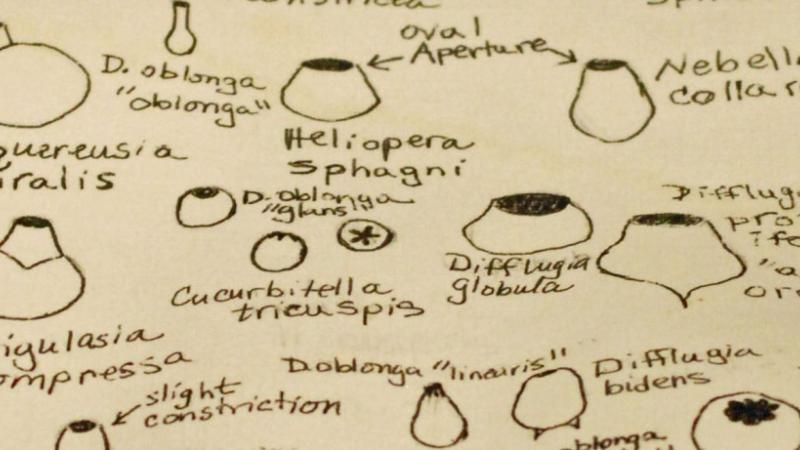August 31, 2015

In a basement lab, Krysia Kornecki reaches into a refrigerator and pulls out a small plastic tub — about half a pint— filled with mud. The mud was skimmed from the bottom of Lake George and in the hands of researchers the information it contains — in the form of microscopic plants and animals, pollen, chemical isotopes, and metal contaminants — will be translated into a biogeochemical history of Lake George.
Kornecki is part of a team of researchers — at Rensselaer and three other institutions — that is using sediment to learn how conditions within the lake have changed over hundreds of years. The team is collaborating with the Jefferson Project at Lake George, and water chemistry information from the project’s sensor network is an integral part of the research. But let’s start with the mud.
Kornecki used a spring activated clamshell shovel called a Ponar grab to scoop samples of mud from the top few inches of the sediment. The research team is also collecting lake cores, cylinders of sediment several feet long extracted from the lake bottom by pushing a hollow tube into the mud. The surface sediment details present-day conditions, while the cores contain mud (and information) deposited over time — a vertical history of the lake — with sediments in the deepest sections reaching back thousands of years.
The researchers pair the present-day surface samples with water chemistry conditions as they currently exist in Lake George (provided by the Jefferson Project). This informs a gauge of the plants, animals, pollen, and chemicals that exist under specific conditions of water chemistry. Kornecki, for example, is researching testate amoebae and ostracods, tiny shelled organisms. In lakes, testate amoebae indicate road salt contamination, phosphorous, and nutrient levels, and can also be used to indicate temperature, acidity, and metal contaminants. Ostracods are an indicator of climate and salinity. As Kornecki explains it, correlating present-day water chemistry with the species and distribution of the amoebae and ostracods opens a window to the past:
At the moment we take actual values and couple them with microfauna that live in the present time. We’re looking at the modern assemblage of plant and animal life in the mud. We take the surface samples, pair them with measurements the Jefferson Project is taking of the lake water chemistry, and then use fossils to look in time before we had sensors to take actual values. That allows us, when we see those same fauna down-core, to know for example the parts per million of organic phosophorous, or salt, present at that time.
Kornecki, a graduate student, is working with Mimi Katz, a Rensselaer assistant professor of earth and environmental sciences and expert in paleoceanography and micropaleontology. In the lab, Kornecki demonstrates how she washes the mud through a stack of three increasingly fine sieves. The top sieve weeds out debris, the middle sieve collects particles as fine as a grain of beach sand, and the bottom sieve —with a mesh 45 microns wide (about .0017 inches) — captures particles about the size of the smallest testate amoebae and ostracods. Kornecki empties the contents of the finest sieve onto a petris dish mounted on a grid, sets it onto a microscope, and painstakingly surveys the dish, one grid square at a time, counting the species and quantity of amoebae and ostracods she finds. She estimated that it takes her about 20 minutes to analyze each dish, and she analyzes about 10 to 15 dishes from each sample.
Each of the scientists using the samples has a different research focus, with its own procedures and outcomes, all revealing different but related aspects of the lake’s history. Morgan Schaller, Rensselaer assistant professor of earth and environmental sciences, is using stable carbon isotope ratios to study nutrient and carbon cycling in the lake. David Gillikin, an assistant professor of geology at Union College, is using nitrogen isotopes as an indicator of wastewater pollution. Francine McCarthy, a professor of earth sciences at Brock University, is using pollen to establish the age of sediments, and dinoflagellates as indicators of nutrient flux, temperature, and acidity. And Curt Stager, a professor of natural science at Paul Smiths College, is using diatoms as an indicator of chloride, phosphate, acidity, and water clarity, relationships which in turn can be linked to climate conditions and human impact.
The team has collected about 30 samples, several in the vicinity of Jefferson Project sensors, and will probably collect several dozen more. Research on the cores has also begun. But that’s a story for a different day.